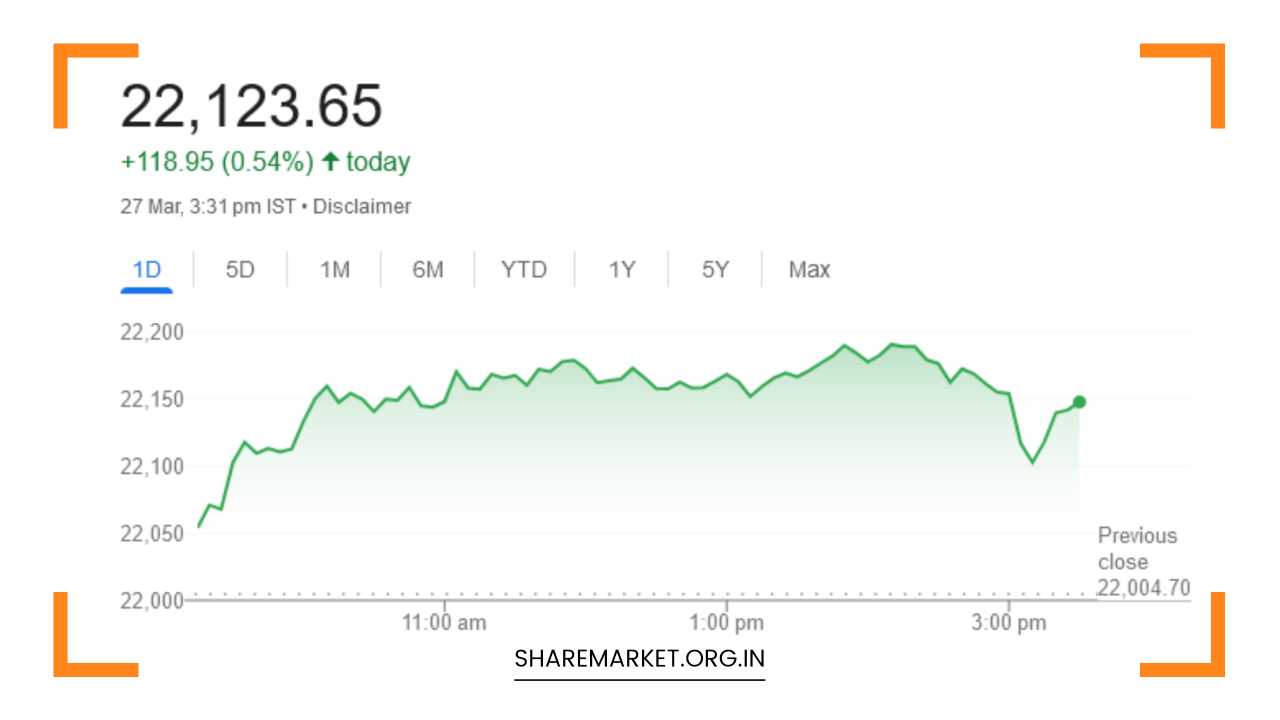Nifty Closed at 22,123; Nifty Prediction for Tomorrow

Nifty Prediction for Tomorrow
The Indian stock market exhibited resilience on March 27th, staging a comeback after the previous day’s losses. This resurgence was primarily fueled by buying activity in heavyweight sectors like auto, realty, power, and capital goods.
The benchmark indices, Sensex and Nifty, closed with respectable gains of 0.73% and 0.54% respectively, settling at 72,996.31 and 22,123.70.
The market commenced the day on a bullish note, shrugging off mixed global cues. Positive sentiment stemmed from the narrowing of the current account deficit (CAD) to $10.5 billion in Q3 and significant buying in leading blue-chip stocks.
Reliance Industries, Maruti Suzuki, Bajaj Auto, Bajaj Finance, and Titan Company emerged as the frontrunners on the Nifty, while Hero MotoCorp, Tata Consumer Products, Apollo Hospitals, Dr Reddy’s Labs, and Wipro witnessed declines.
A Sectoral Deep Dive: Winners and Losers
A deeper examination of sectoral performance reveals interesting trends. Auto, Bank, Capital Goods, Power, Realty, and Telecom indices displayed positive performances, with gains ranging between 0.5% and 1%.
This indicates buying interest across a diversified range of sectors, suggesting a broad-based market uptick. Conversely, Metal, IT, and Media indices closed down by 0.3% to 0.5%.
This could be attributed to profit booking or specific company-related news impacting these sectors. The BSE Midcap index remained flat, indicating a wait-and-watch approach from investors in this segment.
The Smallcap index, however, exhibited a marginal rise of 0.7%, suggesting continued investor interest in smaller companies with high-growth potential.
Individual Stock Performances: Spotlighting Opportunities
Focusing on individual stocks, Zee Entertainment, Tata Chemicals, and Biocon witnessed remarkable surges exceeding 200%.
These significant gains could be due to company-specific positive developments, mergers and acquisitions, or short squeezes. Additionally, long buildups were observed in ABB India, Info Edge, and Metropolis Healthcare.
This extended buying pressure suggests potential for future growth in these stocks. Conversely, short buildups were present in REC, Colgate Palmolive, and Piramal Enterprises.
This short selling activity indicates a bearish sentiment towards these stocks, and investors should exercise caution before taking long positions.
Market Outlook for March 28th: Expert Opinions and Chart Patterns
To gain insights into the potential movement of the market on March 28th, let’s explore the perspectives of market experts and analyze relevant chart patterns.
-
Aditya Gaggar’s Technical Analysis: Mr. Gaggar, Director at Progressive Shares, emphasizes the initial positive momentum of the market on March 27th, driven by select leading stocks. However, the day concluded with the Nifty relinquishing some of its gains. Sector-wise analysis revealed strength in realty and energy sectors, while PSU banks and IT faced selling pressure. Notably, Mr. Gaggar identifies a potentially bullish inverted head and shoulders pattern on the Nifty chart, targeting 22,640 if a breakout occurs. Conversely, he highlights 21,900 as a strong support level that could hold if the Nifty experiences a decline.
-
Jatin Gedia’s Perspective: Mr. Gedia, a Technical Research Analyst at Sharekhan, emphasizes the Nifty’s upward movement throughout the day, resulting in a gain of 119 points. He anticipates further momentum in the ongoing retracement rally and expresses optimism for its continuation. However, Mr. Gedia acknowledges the conflicting signals from daily and hourly momentum indicators, which could lead to consolidation. If the Nifty dips towards 22,100-22,060, he suggests considering it a buying opportunity, targeting 22,215-22,250.
Bank Nifty in Focus: Breakout or Breakdown?
The current market analysis revolves around the Bank Nifty’s consolidation within the 46,500-47,000 range for the past four trading sessions.
This sideways movement signifies indecision between buyers and sellers, with both parties waiting for a decisive breakout.
A breakout, in simpler terms, refers to a price movement that decisively surpasses a significant support or resistance level. In this case, a breakout above 47,000 would indicate a bullish trend, potentially propelling the Bank Nifty towards higher levels in the short term.
Analysts predict targets within the range of 47,270-47,300. Conversely, a breakdown below 46,500 would suggest a bearish trend, potentially leading the Bank Nifty downwards.
Trading Strategies Based on Breakout Direction
Building upon the identified breakout zone, here are potential trading strategies for the Bank Nifty:
-
Upside Breakout (Above 47,000):
- Entry: A long position can be initiated if the Bank Nifty decisively breaks above 47,000, indicating a potential continuation of the uptrend.
- Target: As analysts predict targets within the range of 47,270-47,300, these levels can serve as initial profit booking points. However, depending on market momentum, revised targets based on technical indicators might be considered.
- Stop-Loss: To mitigate potential losses if the price falls back within the consolidation range, a stop-loss order can be placed below 46,530. This stop-loss placement ensures limited downside risk while allowing for some breathing room in case of minor price fluctuations.
-
Downside Breakdown (Below 46,500):
- Entry: A short selling strategy can be implemented if the Bank Nifty decisively breaks below 46,500, suggesting a potential downtrend. It’s crucial to exercise caution, however, as breakdowns can sometimes be false and lead to price reversals.
- Target: Identifying specific downside targets can be challenging. Short sellers may aim for initial profit booking near the next support level, which could be identified using technical analysis tools like Fibonacci retracements or historical support zones.
- Stop-Loss: A stop-loss order should be placed above 47,000 to manage risk in case of an unexpected price surge that invalidates the breakdown thesis. This stop-loss placement ensures limited risk if the breakout above 47,000 turns out to be false.
Risk Management: The Cornerstone of Successful Trading
Regardless of the chosen trading strategy, effective risk management is paramount for long-term success. Here are some key principles to consider:
- Position Sizing: Allocate a reasonable portion of your capital to each trade. The 1% or 2% rule is a commonly used guideline, where you risk no more than 1% or 2% of your total account value on any single trade. This helps spread risk and prevents catastrophic losses from a single bad trade.
- Money Management: Utilize trailing stop-loss orders to automatically lock in profits as the price moves in your favor. This helps secure gains and minimizes potential losses if the price reverses direction.
- Discipline and Patience: Adhere to your trading plan and avoid emotional decision-making. Don’t chase after trades or overstay losing positions. Patience is key, and waiting for the right setup can be more rewarding than impulsive trading.
Additional Considerations Beyond Breakouts
While the breakout strategy is a core focus, here are some additional factors to consider:
- Global Cues: The Indian market is not immune to global influences. Keep an eye on major international events, economic data releases, and central bank policies, as these can significantly impact domestic markets.
- FII and DII Activity: Monitor the activities of Foreign Institutional Investors (FIIs) and Domestic Institutional Investors (DIIs). Net buying by FIIs is generally considered bullish, while net selling can indicate a bearish outlook. Similarly, DII activity can provide insights into domestic investor sentiment.
- Volatility: Increased market volatility can magnify both profits and losses. Be prepared to adjust your trading strategy and risk management parameters accordingly.
Final Thoughts: Navigating the Market Landscape
The Indian stock market presents both opportunities and challenges. By understanding the current market dynamics, analyzing potential breakouts in the Bank Nifty, and implementing sound risk management practices, traders can increase their chances of success.
Remember, this analysis is for informational purposes only and should not be considered financial advice. Always conduct your own research and consult with a qualified financial advisor before making any investment decisions.

















